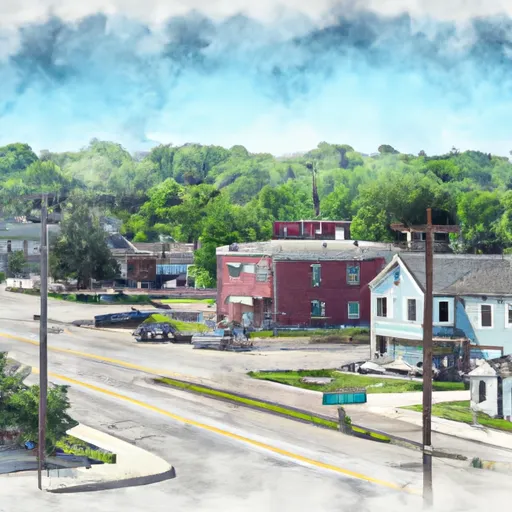-
 Snoflo Premium
Snoflo Premium
Get unlimited access to all our content
With no Ad interruptions! - Start Your Free Trial Login with existing account
South-Rockwood
Eden Index
Climate
8.0
•
Recreation
5.6
•
Community
3.2
•
Safeguard
5.9/10

South-Rockwood is a small village located in Monroe County, Michigan. It experiences a continental climate, characterized by warm summers and cold winters. Summers are moderately humid, with temperatures ranging from the mid-70s to mid-80s Fahrenheit, while winters can be bitterly cold, with temperatures dropping to the 20s and occasional snowfall.
Hydrologically, South-Rockwood is situated near the Huron River, which flows through the village. The river provides a scenic backdrop and offers various recreational opportunities. Fishing enthusiasts can try their luck catching bass, pike, and catfish. Additionally, the nearby Lake Erie, just a short drive away, provides further water-based activities such as boating, swimming, and beachcombing.
Outdoor recreation opportunities abound in South-Rockwood. Nature lovers can explore several nearby parks, including Crosswinds Marsh Wetlands Interpretive Preserve and Sterling State Park. These parks offer hiking trails, birdwatching, and picnicking areas. Additionally, the Huron-Clinton Metroparks system offers a range of outdoor activities, such as golfing, kayaking, and horseback riding, providing ample opportunities to enjoy the natural beauty of the area.
In conclusion, South-Rockwood, Michigan, boasts a moderate climate, proximity to water bodies, and a range of outdoor recreation opportunities, making it an ideal destination for nature enthusiasts and those seeking outdoor adventures.
What is the Eden Index?
The Snoflo Eden Index serves as a comprehensive rating system for regions, evaluating their desirability through a holistic assessment of climate health, outdoor recreation opportunities, and natural disaster risk, acknowledging the profound impact of these factors on livability and well-being.
Climate Health Indicator (CHI): 8.0
South-Rockwood receives approximately
862mm of rain per year,
with humidity levels near 80%
and air temperatures averaging around
10°C.
South-Rockwood has a plant hardyness factor of
6, meaning
plants and agriculture in this region thrive during a short period during spring and early summer. Most
plants will die off during the colder winter months.
By considering the ideal temperature range, reliable water supplies, clean air, and stable seasonal rain or snowpacks, the Climate Health Indicator (CHI) underscores the significance of a healthy climate as the foundation for quality living.
A healthy climate is paramount for ensuring a high quality of life and livability in a region, fostering both physical well-being and environmental harmony. This can be characterized by ideal temperatures, reliable access to water supplies, clean air, and consistent seasonal rain or snowpacks.
Weather Forecast
Streamflow Conditions
Western Lake Erie
Area Rivers
Western Lake Erie
Snowpack Depths
Western Lake Erie
Reservoir Storage Capacity
Western Lake Erie
Groundwater Levels
Recreational Opportunity Index (ROI): 5.6
The Recreational Opportunity Index (ROI) recognizes the value of outdoor recreational options, such as parks, hiking trails, camping sites, and fishing spots, while acknowledging that climate plays a pivotal role in ensuring the comfort and consistency of these experiences.
Access to outdoor recreational opportunities, encompassing activities such as parks, hiking, camping, and fishing, is crucial for overall well-being, and the climate plays a pivotal role in enabling and enhancing these experiences, ensuring that individuals can engage in nature-based activities comfortably and consistently.
Camping Areas
| Campground | Campsites | Reservations | Toilets | Showers | Elevation |
|---|---|---|---|---|---|
| Evergreen County Park | 147 | 740 ft | |||
| Addison Oaks County Park | None | 993 ft | |||
| Otter Lake Park | None | 869 ft | |||
| Metamora - Hadley Rec Area | 215 | 934 ft | |||
| Ortonville State Rec Area | 25 | 1,073 ft | |||
| Sterling State Park | 250 | 579 ft | |||
| Wolverine | 190 | 767 ft |
Nearby Ski Areas
Catastrophe Safeguard Index (CSI):
The Catastrophe Safeguard Index (CSI) recognizes that natural disaster risk, encompassing floods, fires, hurricanes, and tornadoes, can drastically affect safety and the overall appeal of an area.
The level of natural disaster risk in a region significantly affects safety and the overall livability, with climate change amplifying these risks by potentially increasing the frequency and intensity of events like floods, fires, hurricanes, and tornadoes, thereby posing substantial challenges to community resilience and well-being.
Community Resilience Indicator (CRI): 3.2
The Community Resilience Indicator (CRI) recognizes that education, healthcare, and socioeconomics are crucial to the well-being of a region. The CRI acknowledges the profound impact of these elements on residents' overall quality of life. By evaluating educational resources, healthcare accessibility, and economic inclusivity, the index captures the essential aspects that contribute to a thriving community, fostering resident satisfaction, equity, and social cohesion.

